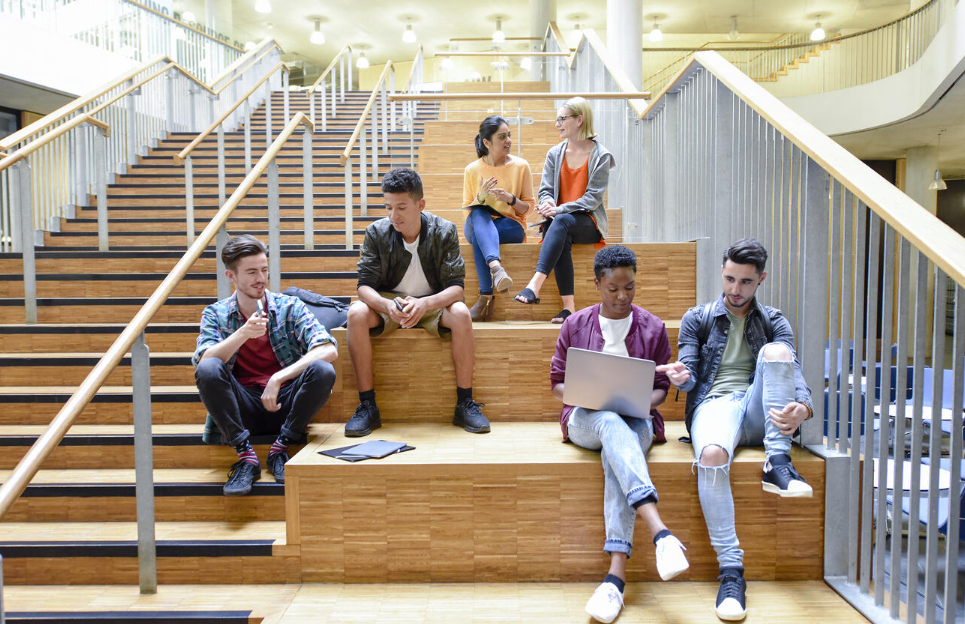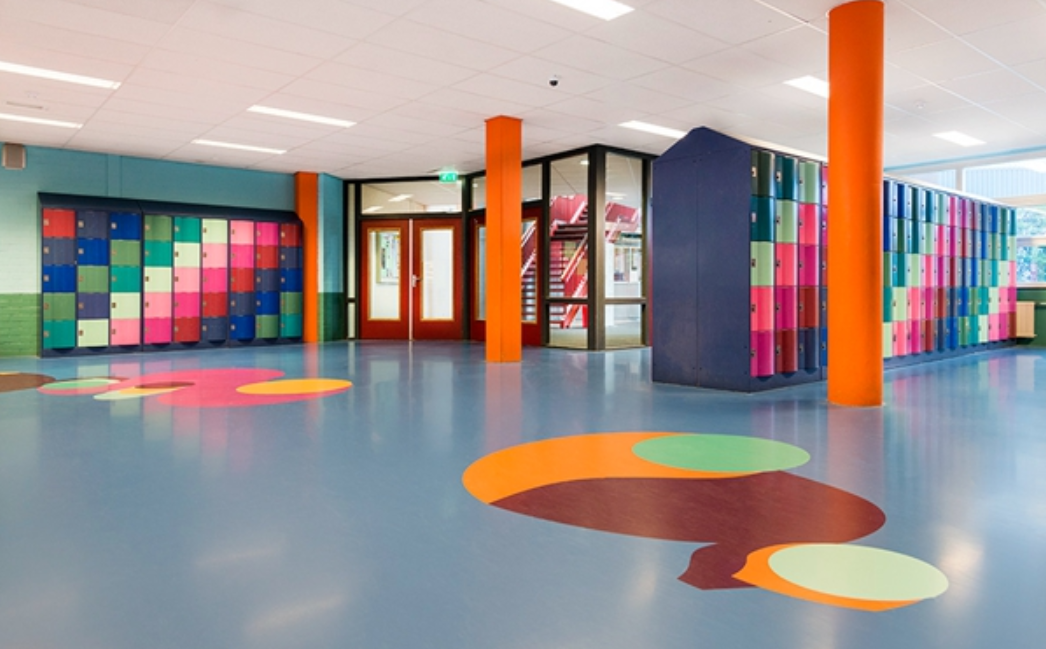School Flooring Options: What Most People Overlook
From my perspective, selecting flooring for a school is about more than just appearances. I believe it’s critical for floors in classrooms, hallways, and gyms to handle spills, constant foot traffic, and the general wear of school life.
You might also be thinking about student comfort, safety, or ways to reduce cleaning expenses. There is a lot to consider. This begs the question: how do you find the best material for each space? Most people I’ve seen focus on the price or durability, but they often miss one important factor.
Choosing the Right Vinyl Flooring for Schools: LVT, VCT, SPC & Sheet Vinyl Compared
Vinyl flooring is a fantastic choice for schools. This includes LVT, VCT, and sheet vinyl. It’s tough, looks great, and is simple to clean. The numbers back this up. The market for school flooring was USD 4.3 billion in 2023. It is expected to hit USD 8.5 billion by 2033. Vinyl is a huge part of this market because it performs well and saves money.
Key Benefits of Vinyl Flooring in Schools
Durability: I’ve seen commercial vinyl take a beating. It holds up to lots of foot traffic. It also resists scratches, stains, and water. If you take care of it, this flooring can last 15–20 years.
Cost-Effectiveness: You’ll save money on upkeep. Maintenance costs are 35–50% lower than other flooring types. You just need to sweep and mop. LVT and sheet vinyl don’t even need waxing. I saw a case study about a school with 1,000 students. They switched from VCT to LVT. This change cut their floor-care costs by over 40% a year. The cost dropped from about ~$2.20/sq ft to ~$1.25/sq ft over 20 years.
Design Flexibility: I like the design options. Vinyl comes in thousands of colors and patterns. You can use it to create paths or show off school colors and logos.
Safety & Hygiene: Keeping kids safe and healthy is a top priority. I recommend slip-resistant vinyl. Sheet vinyl can be installed without seams, which means fewer places for germs to hide and less risk of tripping. This makes cleaning easy and helps control infections in shared areas.
Noise Reduction: Vinyl floors help make classrooms quieter. This helps students focus and feel better. I suggest you get it with a sound-dampening backing for the best result.
Sustainability: If you care about the environment, you’ll find good options. Many vinyl products use a lot of recycled material. They also have Environmental Product Declarations (EPDs). This helps you meet goals for LEED and other green building standards.
Where I Recommend Using It
Classrooms: I suggest LVT or VCT here. They are durable and work for many different activities.
Hallways & Corridors: These areas need floors that can handle heavy traffic and rolling carts. Vinyl is a great choice because it’s tough and easy to clean.
Cafeterias & Dining Rooms: For these spaces, I’d go with sheet vinyl or a slip-resistant LVT. They are perfect for handling spills and constant use.
Offices & Multipurpose Rooms: People choose vinyl here because it looks good and is practical.
Entryways: Sheet vinyl works best for entrances and science labs. This is true in places with bad weather because it resists moisture so well.
Exploring Carpet Tiles as One of the Best Flooring Options for Schools
Carpet tiles are a core part of a school’s flooring plan. In schools with carpeting, these tiles cover about 70–75% of the floor. You’ll find them in libraries, classrooms for younger students, offices, and music rooms. Other places, like cafeterias and hallways, get smooth flooring because it is more practical.
My Thoughts on Key Benefits in Schools
Great Sound Absorption: I believe carpet tiles are excellent at reducing noise. This helps create quieter, more focused spaces, which is vital in a school. For example, Klein Cain High School (Klein ISD) uses carpet tiles in its library. This lowers surface noise and helps students work in groups.
Comfort and Safety: These tiles make a softer floor. This feels more comfortable for students and staff who are inside for many hours.
Easy Repairs: I like how simple they are to fix. If a tile gets worn out or stained, you just pull it up and replace it. This cuts down on waste and makes maintenance easy.
Smart Designs: I’ve noticed many schools pick darker or patterned designs. This is a smart choice to help hide dirt between cleanings.
My Recommended Maintenance Plan
I suggest daily vacuuming. This removes dry dust and dirt, which makes up over 75% of the soil in a typical carpet.
Spot cleaning is great for taking care of spills right away.
A deep cleaning during school breaks will help the carpet last longer and improve hygiene.
I recommend choosing tiles with antimicrobial and stain-resistant coatings. They help keep the school healthy and are simple to clean.
Where I Suggest Placing Carpet Tiles
Best for: I recommend them for libraries, music rooms, and administrative offices. They are also perfect for classrooms where you need quiet and comfort.
Not suitable for: I would not use them in wet or spill-heavy areas like cafeterias, kitchens, or art rooms. In those places, a smooth floor is the better choice.
Laminate Flooring: A Good Option for Schools? Pros and Limitations
I’ve seen many schools choose laminate flooring. It’s a great way to get nice-looking floors without spending a lot. I can tell you where laminate works well and where it doesn’t.
Cost and Installation Speed
A Budget-Friendly Pick: Based on my experience, commercial-grade laminate is easy on the budget. You can expect to pay $2–$4 per square foot for materials. This is much cheaper than rubber ($8–$12) or luxury vinyl ($5–$8).
Saves on Labor: I recommend its click-lock or floating floor design. This feature makes installation fast. Schools tell me this shortens how long it takes to install. That means less disruption for classes and lower labor costs.
A Real-World Example: I saw a good example of this recently. A Midwest elementary school used AC4-rated laminate in its lounges and offices in 2024. They saved 35% on flooring costs compared to installing vinyl. The installation was fast. I did notice that after two years, the floors in busy hallways showed some scuffs and looked a bit dull.
Durability, Care, and Weaknesses
Service Life: I find that commercial-grade laminate can last 10–15 years in areas with medium foot traffic. This lifespan depends on correct cleaning and care.
My Care Guidelines: In my opinion, keeping it clean is simple. You need to sweep it each day and use a damp mop sometimes. Do not use a wet mop. I suggest using entrance mats to catch dirt and water. You must lift furniture instead of dragging it and use felt pads on the legs.
Wear Layer Strength: The surface helps the laminate resist stains and fading. But I must stress that water is laminate’s biggest weakness. If water sits on it, the floor can swell, the seams can pull apart, or it can warp for good.
Key Data: I saw a 2022 study that confirms this. It found that 58% of laminate flooring problems in classrooms came from moisture damage at the seams. In dry office areas, the replacement rate is much lower, at just 1–2% per year.
Best Areas: Based on my experience, I recommend using laminate in places like offices, guidance rooms, staff spaces, and private offices. These are areas with a low risk of spills and moderate foot traffic.
Where to Avoid: I would not use laminate in cafeterias, restrooms, or entranceways. These areas often get wet from spills, boots, or heavy cleaning.
Comfort, Sound, and Warranties
Sound and Comfort Issues: Laminate is a hard surface that is not very comfortable for standing. I also find it transmits footstep noise. This makes it a poor choice for quiet areas. A sound-dampening underlayment can help, but it won’t be as quiet as carpet or rubber.
A Note on Warranties: Most brands give you a 10-year commercial warranty. Be careful, because water damage or incorrect cleaning will cancel that warranty.
My Maintenance Tips
My top tip is to always use AC4 or higher wear-rated laminate in a school.
I suggest you install walk-off mats at every entrance to catch dirt and water.
Make sure your staff lifts furniture instead of dragging it. Put felt pads on all table and chair legs.
You should never wet mop. I recommend using a damp mop with very little water.
My advice is to avoid putting laminate anywhere the risk of moisture is moderate or high.
Porcelain Tile as a School Flooring Option: Durable, Hygienic, and Stylish
Porcelain tile is a top choice for school floors because it’s strong and lasts a long time. I have watched it hold up to heavy student traffic in busy areas like hallways and cafeterias without a scratch. Its tough surface handles the wear and tear of school life, year after year.
Key Benefits of Porcelain Tile in Educational Spaces
Outstanding Longevity: With basic care, these floors can last 20–50 years or more. I find this incredible durability means you spend less on maintenance and replacement over time.
Moisture and Stain Resistance: Porcelain tile absorbs almost no water—the standard is a 5% water absorption rate. This means it fights off spills, stains, and germs. That’s why I recommend it for places like restrooms, locker rooms, and cafeterias.
Health and Hygiene: Its smooth, non-porous surface is simple to clean. This helps keep the air inside clean by cutting down on allergens and moisture where germs can grow.
Design Options: You get a lot of design freedom. There are so many colors, styles, and textures to choose from. You can match your school’s branding or create different looks for specific zones.
Where Porcelain Tile Performs Best
Classrooms: Tile withstands moving furniture and heavy student foot traffic. I suggest adding area mats to reduce noise and boost comfort.
Cafeterias and Kitchens: I like using tile here because it resists food stains, spills, and water. A great example is Eastland-Fairfield Career and Technical Schools. They used porcelain tile in their culinary kitchen to deal with constant spills and foot traffic.
Restrooms and Locker Rooms: Because it resists water and germs, porcelain is a trustworthy choice for these rooms. I must stress, though: always use textured tiles here to prevent slips.
Entryways and Lobbies: The tile’s toughness stands up to tracked-in moisture, dirt, and salt. Tiles also resist sun fading in areas with strong natural light.
My Guide to Polyurethane/Sports Resin Floors (“Pad and Pour”)
“Pad and pour” floors are a great choice for school gyms and multi-use areas. I see them built as a system with multiple layers:
Base Layer: This is a shock pad made from 100% recycled rubber. It comes in 4 mm, 7 mm, or 9 mm thicknesses. The thickness you choose controls the floor’s shock absorption. I find you can customize this from 15% up to 45%.
Intermediate Layers: Next, installers add flexible resin and seal coats. These give the floor strength and a smooth finish.
Top Layer: The final layer is about 2 mm of polyurethane. You can get special water-based coatings. I find these are great at resisting stains and are simple to clean.
Performance, Durability, and Safety I See
I always check safety standards. These floors meet or beat the ASTM F-2772 Sports Flooring Standard. This covers force reduction, ball rebound, and slip resistance.
I’ve seen these floors handle heavy loads well. They provide great shock absorption and distribute weight evenly. You can use heavy bleachers and rolling tables on them without causing damage.
They have excellent resistance to scuffs, scratches, and spills. I think this is a huge benefit for any busy school.
The surface is flexible and absorbs sound. This makes the space quieter. It also helps reduce injuries from impacts during sports.
The technical specs are a good indicator of durability. These floors have a minimum tensile stress of 1,500 kPa (220 psi). They can also stretch up to 250%. I see this as proof that they flex under pressure and bounce back.
My View on Customization & Design Flexibility
Your color choices can be limited. You can pick from standard shades or order custom colors. This is good for showing school spirit.
The game lines are permanent because they are bonded to the floor. This ensures your sports courts stay clear and accurate.
You can also customize the texture and resilience. I recommend tailoring this to fit your building’s specific needs.
Installation and Technical Details to Know
I believe professional installation is essential. The floors need careful layering and curing. This ensures you get the best performance.
The subfloor must be very flat. The tolerance is only plus or minus 3 mm over 3 meters. This is critical for a seamless finish. Expansion joints are only placed at the edges.
A typical installation has a minimum width of 1,500 mm (60 inches). I make sure it always includes at least a 2 mm polyurethane top layer.
Sheet Linoleum Flooring: A Sustainable and Healthy Choice for Schools
Sheet linoleum stands out as a resilient flooring option for schools focused on sustainability, indoor air quality, and long-term value. It is made from nearly all-natural materials—linseed oil, wood flour, cork dust, and jute backing. This makes it one of the most eco-friendly choices, as well as being free from PVC and phthalates. Many products are certified by authorities such as FloorScore or Cradle to Cradle, supporting green building standards in educational settings.
Key Performance and Durability Benefits
Meets Commercial Standards: Sheet linoleum is produced to meet ASTM F2034 standards, ensuring its suitability in commercial and light commercial school applications.
Long Service Life: Properly cared for, linoleum flooring can last 25 years or more in schools. It is rated for general and light practical flooring—common in classrooms, libraries, and corridors.
Antimicrobial Properties: I find linoleum notable for its natural ability to reduce bacteria. Lab studies show up to 99% reduction in common bacteria like E. coli and Staphylococcus aureus after 24 hours, aiding hygiene.
Fire Safety: Most brands are rated Class 1 for fire resistance (ASTM E648), making linoleum safe for high-traffic educational buildings.
Material Strength: Typical specifications include minimum 2 mm thickness, a slip resistance coefficient of 0.6 or higher (dry), and permanent indentation below 0.15 mm under load.
Installation, Maintenance, and Cost Considerations
Upfront Cost: Installed prices average $6–$10 per sq ft. This is higher than basic vinyl, but is justified by long service life and eco-certifications.
Low Ongoing Maintenance: Annual maintenance costs are just $0.10–$0.20 per sq ft. Gentle, neutral pH cleaners are all you need—harsh chemicals can cause permanent damage.
Seam Handling: All seams should be heat-welded or tightly sealed to prevent water ingress, especially important in busy classrooms or multipurpose spaces.
Color Longevity: Linoleum is moderately colorfast. Direct sunlight can fade colors, so I recommend window treatments in areas with a lot of natural light.
Where Sheet Linoleum Excels in Schools
Classrooms and Kindergartens: Comfortable underfoot and soft enough to reduce fatigue, it also helps lower noise, a big benefit for younger grades.
Multipurpose Rooms and Libraries: Durable and easy to maintain, linoleum handles shifting furniture and constant use.
Corridors: Fewer seams (common 2m-wide rolls) mean fewer places for dirt and germs to hide, supporting school hygiene goals.
Matching Flooring to Function: A Smarter Approach for Schools
Many decision-makers tend to focus only on price or appearance when selecting school flooring. However, each area within a school—such as gyms, libraries, and cafeterias—has unique functional demands. Gym floors require impact resistance, while cafeterias need surfaces that resist spills and frequent cleaning.
To make a lasting investment, it’s essential to choose flooring materials based on the specific needs of each space. This includes prioritizing student safety, comfort, and long-term maintenance costs. A well-matched solution ensures the flooring supports both functionality and the educational environment for years to come.






